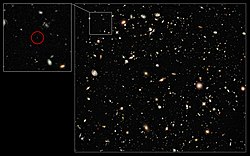UDFy-38135539
UDFy-38135539(又名为:"HUDF.YD3")是人类观测到的经光谱确认的最遥远的天体(截至2010年10月),也是当前宇宙中已知存在的第三遥远的天体(排在UDFj-39546284之后)。经计算它的光行距离超过40亿秒差距[2],同移距离为91亿秒差距[3]。UDFy-38135539(哈勃超深空(UDF)的星系分类)最初于2009年9月由三个科学小组从哈勃太空望远镜红外线图像中发现[4][5][6]。
| UDFy-38135539 | |
|---|---|
 哈勃太空望远镜拍摄的UDFy-38135539图像 | |
| 观测资料 | |
| 星座 | 天炉座 |
| 红移 | 8.55[1] |
| 距离 | 超过13Gly |
| 其他名称 | |
| HUDF.YD3 | |
发现
编辑2009年8月至9月,UDFy-38135539星系的景象由哈勃太空望远镜于近期配置的第三代广域照相机所拍摄的哈勃超深空捕捉到[1][7]。之后图像数据被传至科学界,最终由Bouwens[4]、Bunker[5]和McLure[6]等小组发现,随后Lehnert等人的小组进行了光谱证实。这项成果被公布在2010年的《自然》杂志上的一篇题为"红移为z=8.6的星系光谱证实"(英文标题:Spectroscopic Confirmation of a Galaxy at Redshift z=8.6)的文章中[8][9]。Lehnert的小组在成果发表于自然杂志以前曾对星系进行了16小时的观测以及对结果展开为期2个月以上的分析[9]。
特征
编辑UDFy-38135539位于天炉座,距离地球40多亿秒差距[2],超过130亿光年。星系的光线红移达到了8.55。相比之下之前最遥远的天体纪录保持者伽玛射线暴GRB 090423的光线红移为8.2[8]。据估计,UDFy-38135539大概拥有10亿颗恒星[10],它的直径只有银河系的十分之一,不到银河系恒星质量总和的百分之一。从地球上看到的来自星系的光线是从130亿年以前发出的,距大爆炸仅有6亿年[11],那时宇宙只有当前年龄的4%[9]。
UDFy-38135539的光度距离为860.9亿秒差距,大约是2830亿光年。在宇宙学中有数种不同的距离测量方法,光行距离和光度距离有别于用来定义可观测宇宙大小的同移距离[12][13]。光度距离 和一种叫横向同移距离(comoving transverse distance) 的因素相关,用等式表示就是: ,其中z是红移,而在平坦宇宙中横向同移距离本身等于径向同移距离(radial comoving distance)[14][15]。所以由 = 860.9亿秒差距及z=8.55可得知同移距离之值为91亿秒差距(大约是300亿光年)[3]。
后续发现
编辑科学家们希望能够发现更古老的星系。但每当星系的年龄越接近大爆炸的时间点时,星系的数量就会相应地减少,它们发出的光线也就越灰暗。毕竟普遍上这些拥有更少可观测恒星数量的星系发出的光芒相当的微弱,随着距离的增加,在寻找上的难度上也会大幅度提升[16]。将于2014年投入使用的詹姆斯·韦伯太空望远镜有能力观测到134亿光年以外,诞生时间早于宇宙大爆炸3亿年之后的星系。预定于2018年完成的欧洲极大望远镜的镜片直径比甚大望远镜(Yepun)的大五倍[17],可以使人类对134亿光年以外的星系作更详细的研究[18]。
参见
编辑参考资料
编辑- ^ 1.0 1.1 Dim galaxy is most distant object yet found. New Scientist. [2010-10-21]. (原始内容存档于2013-06-23).
- ^ 2.0 2.1 Trenti, Michele. Astronomy: Galaxy sets distance mark. Nature. 2010, 467: 924–925. doi:10.1038/467924a.
- ^ 3.0 3.1 Edward L.(Ned)Wright. Cosmology Calculator I. Astronomy @ UCLA. [2010-10-22]. (原始内容存档于2018-09-29).
- ^ 4.0 4.1 R.J. Bouwens, G.D.Illingworth, P.A. Oesch, M. Stiavelli, P. van Dokkum, M. Trenti,D. Magee, I. Labbe, M. Franx, M. Carollo and V. Gonzalez. Discovery of z~8 Galaxies in the HUDF from ultra-deep WFC3/IR Observations. Astrophysical Journal. [2010-10-22]. (原始内容存档于2017-05-10).
- ^ 5.0 5.1 Andrew Bunker, Stephen Wilkins, Richard Ellis, Daniel Stark, Silvio Lorenzoni, Kuenley Chiu, Mark Lacy, Matt Jarvis and Samantha Hickey. The Contribution of High Redshift Galaxies to Cosmic Reionization: New Results from Deep WFC3 Imaging of the Hubble Ultra Deep Field. Monthly Notices of the Royal Astronomical Society. [2010-10-22]. (原始内容存档于2018-04-02).
- ^ 6.0 6.1 R.J. McLure, J.S. Dunlop, M. Cirasuolo, A.M. Koekemoer, E. Sabbi, D.P. Stark, T.A. Targett and R.S. Ellis. Galaxies at z = 6 - 9 from the WFC3/IR imaging of the HUDF. Monthly Notices of the Royal Astronomical Society. [2010-10-22]. (原始内容存档于2018-04-03).
- ^ Matson, John. Early Bloomer: Faraway Galaxy Pushes Cosmic View Closer to the Dawn of the Universe. Scientific American. [2010-10-21]. doi:10.1111/j.1365-2966.2009.16176.x. (原始内容存档于2012-10-16).
- ^ 8.0 8.1 Alan Boyle. Scientists pinpoint the farthest galaxy. MSNBC. 2010-10-15 [2010-10-21]. (原始内容存档于2010-10-22).
- ^ 9.0 9.1 9.2 David Derbyshire. Astronomers find most remote galaxy ever seen... 13 BILLION light years away. DailyMail.co.uk. [2010-10-21]. (原始内容存档于2017-01-01).
- ^ Long Ago and Far, Far, Away: The Oldest Thing Ever Seen in the Universe. Fox News. 2010-10-20 [2010-10-23]. (原始内容存档于2011-01-31).
- ^ Astronomers Find Oldest Galaxy Yet. ABCNews. 2010-10-20 [2010-10-23]. (原始内容存档于2019-12-07).
- ^ Davis, Tamara M.; Charles H. Lineweaver. Expanding Confusion: common misconceptions of cosmological horizons and the superluminal expansion of the Universe. Publications of the Astronomical Society of Australia. 2004, 21 (1). doi:10.1071/AS03040. 外部链接存在于
|title=(帮助) - ^ Gott III, J. Richard; Mario Jurić, David Schlegel, Fiona Hoyle, Michael Vogeley, Max Tegmark, Neta Bahcall, Jon Brinkmann. A Map of the Universe. The Astrophysics Journal. 2005, 624 (2). doi:10.1086/428890. 外部链接存在于
|title=(帮助) - ^ Gabrielli, Andrea. Statistical Physics for Cosmic Structures, p. 377 (页面存档备份,存于互联网档案馆).
- ^ A Cosmology and Cosmography. Mpifr-bonn.mpg.de. 2005-09-21 [2010-10-22]. (原始内容存档于2011-01-02).
- ^ Oldest Object in Universe Found. Discovery News. [2010-10-21]. (原始内容存档于2010-10-22).
- ^ Galaxy is most distant object yet. BBC News. [2010-10-21]. (原始内容存档于2019-04-17).
- ^ Most distant galaxy identified. Telegraph.co.uk. [2010-10-21]. (原始内容存档于2014-08-10).
| 纪录 | ||
|---|---|---|
| 上一纪录: GRB 090423 |
最遥远的天体 2010年-2011年 |
下一纪录: UDFj-39546284 |
| 上一纪录: IOK-1 |
最遥远的星系 2010年-2011年 |
下一纪录: UDFj-39546284 |